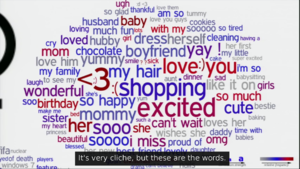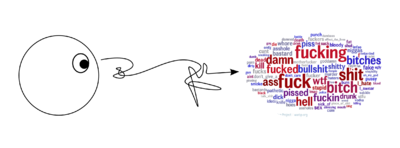I-could-have-written-that: Difference between revisions
No edit summary |
No edit summary |
||
| Line 5: | Line 5: | ||
|Thumbnail=I-could-have-written-that these-are-the-words mb.png | |Thumbnail=I-could-have-written-that these-are-the-words mb.png | ||
|Website=http://www.manettaberends.nl | |Website=http://www.manettaberends.nl | ||
|Description=''i-could-have-written-that'' is a workshop on the subject of text mining, a technology that uses statistics and computational linguistics to extract knowledge from the overwhelming amount of digital | |Description=''i-could-have-written-that'' is a workshop on the subject of text mining, a technology that uses statistics and computational linguistics to extract knowledge from the overwhelming amount of digital texts that are published online. Under mottos like ''"the power to know"'', text mining services offer pre-trained classifiers through APIs without specifying how the system is created. The workshop challenges the image of this modern oracle, by discussing how the software, work process and vocabulary together construct text mining outcomes. more info: [http://i-could-have-written-that.info i-could-have-written-that.info] | ||
}} | }} | ||
[[File:Perceiving-a-wordcloud.png|400px]] | [[File:Perceiving-a-wordcloud.png|400px]] | ||
The overwhelming amount of digital text available these days, is presented as the problem that can be solved by algorithmic processes: text mining. Text classification is one of subsections, in which statistics are combined with techniques that process natural language. The technology is used widely to detect i.e. sentiment, depression, education level, | The overwhelming amount of digital text available these days, is presented as the problem that can be solved by algorithmic processes: text mining. Text classification is one of its subsections, in which statistics are combined with techniques that process natural language. The technology is used widely to detect i.e. sentiment, depression, education level, pedophilia or to prevent terrorism. Text mining is presented with untenable enthusiasm and a strong belief in its reading abilities. However, an actual training process is messy and chaotic. Although the eventual results are presented as being read or mined from the text, they show more similarities to something that is written. This research project shows how text mining results are never an absolute truth, but are constructed through a collaboration between the software, the metaphors that are used, the text miner and the authoritative power of language. | ||
Revision as of 14:13, 9 June 2016
| I-could-have-written-that | |
|---|---|
| Creator | Manetta Berends |
| Year | 2016 |
| Bio | Manetta Berends (NL) has been educated as a graphic designer at ArtEZ, Arnhem before starting her master-education at the Piet Zwart Institute (PZI), Rotterdam. From an interest in linguistics, code and a research based design practice, she currently works on the systemization of language in the field of natural language processing and text mining. |
| Thumbnail | |
| Website | http://www.manettaberends.nl |
i-could-have-written-that is a workshop on the subject of text mining, a technology that uses statistics and computational linguistics to extract knowledge from the overwhelming amount of digital texts that are published online. Under mottos like "the power to know", text mining services offer pre-trained classifiers through APIs without specifying how the system is created. The workshop challenges the image of this modern oracle, by discussing how the software, work process and vocabulary together construct text mining outcomes. more info: i-could-have-written-that.info
The overwhelming amount of digital text available these days, is presented as the problem that can be solved by algorithmic processes: text mining. Text classification is one of its subsections, in which statistics are combined with techniques that process natural language. The technology is used widely to detect i.e. sentiment, depression, education level, pedophilia or to prevent terrorism. Text mining is presented with untenable enthusiasm and a strong belief in its reading abilities. However, an actual training process is messy and chaotic. Although the eventual results are presented as being read or mined from the text, they show more similarities to something that is written. This research project shows how text mining results are never an absolute truth, but are constructed through a collaboration between the software, the metaphors that are used, the text miner and the authoritative power of language.


